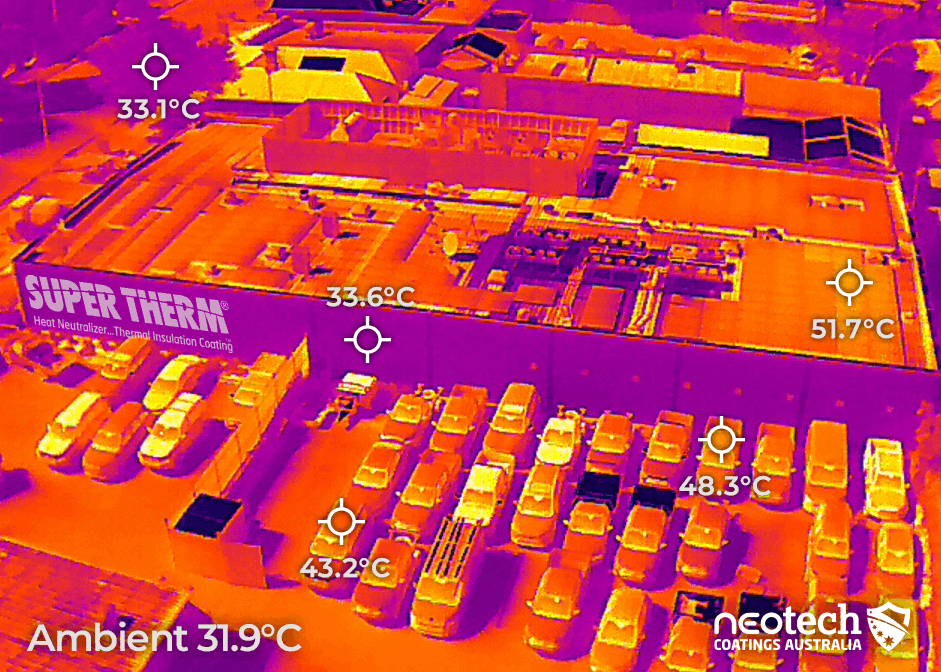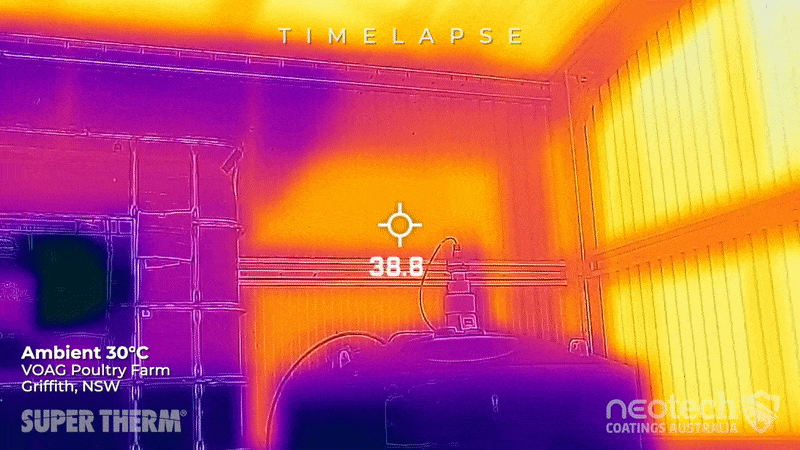Envelope Wall Insulation Coating with Super Therm

A thermal envelope aims to form an environment that prevents drafts and heat transfer from a building’s exterior to interior or interior to exterior.
In the winter, a house with a reliable thermal envelope prevents air leaks; in other words, it keeps warm air inside and cold outside. In summer, however keeping the sun’s harsh heat out is the primary goal! Super Therm® blocks heat!
Urban warming is a critical challenge that negatively impacts human health, energy use, air quality, social equity, and economic prosperity. In a world that is growing hotter by the year, cities in particular are suffering from an increase in extreme heat waves and heat-related deaths.
Our expertise shows that blocking heat load on the walls is a viable mechanism for urban heat island (UHI) mitigation, and that the ability of solar thermal blocking and reflective walls in combating the UHI effect is the same with Super Therm® as with cool roofs. We cool surfaces! No matter the surface, bricks, concrete and anything else, Super Therm® will block the heat load!
Exterior walls can help reduce urban heating and building energy use, and how third-party product ratings help occupants, builders, architects, and policymakers make informed product decisions that go beyond the roof to the built environment.
Walls are a vital part of the envelope of a building including the roof. Insulating walls either externally or internally is important for the energy efficiency of a building. If you block the heat load into the thermal mass of a wall you’ll reduce the excessive heat transfer into the building.
Why does Super Therm work to block heat on external walls?
Super Therm works to block heat on walls through several key mechanisms:
- Thermal Blocking & Reflectivity: Super Therm® is designed to reflect up to 96.1% of solar radiation. This includes infrared (IR) radiation, which is a major component of heat from the sun. By reflecting and blocking this radiation, Super Therm® prevents the walls from absorbing and transferring heat into the building.
- Insulating Properties: Super Therm® contains a blend of ceramic compounds that provide a thermal barrier. These ceramics have low thermal conductivity, which means they slow down the transfer of heat through the coating, reducing the amount of heat that penetrates the walls.
- Emissivity: The coating has high emissivity, allowing it to emit absorbed heat quickly. This property helps in reducing the heat buildup on the surface of the walls, maintaining a cooler interior.
- Durability and Flexibility: Super Therm® forms a flexible and durable barrier that can withstand extreme weather conditions without cracking or degrading. This ensures long-term protection and consistent performance in blocking heat.
- Moisture Resistance: The coating is also designed to be moisture resistant, preventing the absorption of water which can contribute to heat transfer through the process of evaporation and condensation.
Overall, these properties make Super Therm® an effective solution for reducing heat gain in buildings, leading to lower energy costs for cooling and improved indoor comfort.
Solar Heat Block on a Data Centre Wall…Reduce the risk with Super Therm®
Inside the building
Heat can be lost or gained through the walls. Drywall or Gyprock® plasterboard products themselves don’t have a significant impact on heat loss or heat retention. However, the insulation behind the drywall / plasterboard and the overall construction of the building play crucial roles in heat loss or retention.
Plasterboard is primarily used as an interior wall covering material and does provide some thermal resistance, but its insulation properties are limited. The primary purpose of drywall is to provide a smooth and fire-resistant surface, rather than to act as a significant insulator. Plasterboard itself does not have significant air-blocking properties. It is a porous material and allows for some air movement. However, when installed properly, drywall can contribute to the overall air tightness of a building.

To effectively address heat loss or retention in a building, proper insulation and reducing air flow is key. Insulation materials such as fibreglass, foam boards, or spray foam are typically installed within the walls, ceilings, and floors to minimise heat transfer. These insulation materials are designed to reduce heat loss during the colder months and heat gain during the warmer months. But do they work well? Typically walls have an R 2.5 insulation which is pushed into the wall assembly. The average thickness of R 2.5 fibreglass insulation is 60mm.
The minimum R-values for insulation based on different climate zones in Australia for wall insulation:
- Climate Zone 1 (Hot humid summer, warm winter): R2.0
- Climate Zone 2 (Warm temperate): R2.0
- Climate Zone 3 (Mild temperate): R2.0
- Climate Zone 4 (Cool temperate): R2.7
- Climate Zone 5 (Alpine regions): R2.7
Additionally, other factors such as air sealing, the quality of windows and doors, and the overall construction of the building, including the presence of thermal bridges, can also impact heat loss or retention. It’s important to consider a holistic approach to insulation and energy efficiency in buildings to minimize heat loss and create a more comfortable and energy-efficient environment. It’s important to note that insulation reduces heat transfer but does not completely eliminate it. Heat transfer will occur, albeit at a slower rate, through any insulation material.
24°C is the laboratory testing temperature for measuring R-values of insulation materials
The average laboratory testing temperature for measuring R-values of insulation materials is typically around 24°C (75°F). This temperature is commonly used as a standard reference point for testing and comparing the thermal performance of different insulation products.
The American Society for Testing and Materials (ASTM) has established guidelines and standards for testing insulation materials, including the determination of R-values. The testing is typically performed in a controlled laboratory environment, where the temperature is stabilised at 24°C. This temperature is chosen because it represents a moderate climate condition and is considered to be a reference point for comparing insulation materials.
It’s important to note that the R-value of insulation materials can vary with temperature. Some insulation materials, such as foam-based products, may exhibit slightly different R-values at different temperatures. Therefore, it’s essential to consider the specific temperature conditions and any potential thermal drift associated with the insulation material being used.
Heat transfer through fibreglass insulation, like most insulation materials, generally occurs at a faster rate at higher temperatures. This is because heat transfer is driven by the temperature difference between two areas. When the temperature difference is larger, the heat transfer rate tends to increase.
Fiberglass insulation has a thermal conductivity (k-value) that represents its ability to conduct heat. Typically, the thermal conductivity of insulation materials increases with temperature, meaning heat transfers more readily as the temperature rises.
So, at 40°C compared to 24°C, heat is likely to move faster through fibreglass insulation due to the larger temperature difference. This indicates that the insulation’s effectiveness in reducing heat transfer is reduced at higher temperatures. Once the fibreglass reaches heat flux then it is equal to the higher heat temperature. As R values are only tested in a lab at 24°C, not field tested then the value of the insulation is reduced significantly.
It’s important to consider that the actual impact on heat transfer depends on various factors, including the insulation’s thickness, density, and overall construction, as well as the specific temperature conditions and other environmental factors. For precise information on the performance of a particular insulation material at different temperatures, it is advisable to consult the manufacturer’s specifications or seek guidance from a qualified professional.

Moisture impact
Moisture in fibreglass insulation can increase the rate of heat transfer and reduce its overall thermal performance. When insulation becomes damp or wet, it can significantly impact its ability to resist heat transfer and decrease its effective R-value.
Moisture affects insulation in several ways:
- Conductive heat transfer: Moisture acts as a conductor of heat, and when it is present in insulation, it enhances the conduction of heat through the material. This can lead to increased heat transfer.
- Decreased thermal resistance: The presence of moisture can reduce the thermal resistance of the insulation. Moisture-filled air pockets or wet fibers in fiberglass insulation can create pathways for heat to bypass the insulation, resulting in reduced thermal resistance.
- Increased convective heat transfer: Moisture can also increase convective heat transfer within the insulation. When moisture is present, it can promote the movement of air within the insulation, further facilitating heat transfer.
The specific impact of moisture on heat transfer in fibreglass insulation can vary depending on factors such as the extent of moisture accumulation, insulation thickness, insulation density, and other environmental conditions. It is challenging to provide an exact quantification of how much the rate of heat transfer increases in the presence of moisture, as it depends on these variables.
However, it is recognised that moisture in insulation has a detrimental effect on its thermal performance.
Therefore, it is crucial to prevent moisture infiltration into insulation materials and address any moisture-related issues promptly to maintain their effectiveness in reducing heat transfer.
Concrete absorbs heat…it is a large Thermal Mass!
Thermal mass is the ability of a material to absorb, store and release heat. Thermal lag is the rate at which a material releases stored heat. For most common building materials, the higher the thermal mass, the longer the thermal lag.
Materials with high thermal mass and long lag times are often simply referred to as ‘thermal mass’. These are typically heavyweight construction materials like concrete, brick and stone. Materials with low thermal mass are typically lightweight construction materials, like timber frames (source).
R values aren’t linear
The relationship between the R-value of insulation and its thickness is not linear. The R-value of insulation is determined by the thermal resistance of the material, which depends on its thickness, thermal conductivity, and other factors.
Adding more thickness to insulation generally increases its R-value, but the increase is not linear. The R-value typically follows an asymptotic curve where the initial increase in thickness has a more significant impact on the R-value, and as the thickness increases, the incremental increase in R-value becomes smaller.
This diminishing return effect occurs because insulation materials have diminishing thermal conductivity with increasing thickness. As the thickness of the insulation increases, the heat transfer pathways through the material become longer, and the resistance to heat flow increases.
For example, if you have insulation with an initial thickness of 2 inches and an R-value of 10, doubling the thickness to 4 inches may increase the R-value to 18 or 20. However, doubling the thickness again to 8 inches may only result in a smaller increase, such as an R-value of 22 or 24.
It’s important to note that the specific relationship between thickness and R-value can vary depending on the insulation material and its properties. Different insulation materials have different thermal conductivities and behaviour. Therefore, it is recommended to consult the manufacturer’s specifications or relevant engineering guidelines for accurate information on how adding thickness affects the R-value of a particular insulation product.











